Creating non-scripted destructible environments that are both fun and realistic, yet limited enough so that the player can’t break the game has been a serious challenge in the past. But many games have gotten them right, and thus have been a blast to play.
Since gaming started to take off in the ’80s, through the transition from 2D to 3D in the mid-’90s, and into today’s high definition, online multiplayer epics, developers have been able to utilize increasingly powerful hardware to create destructible environments. Brace yourself for some of the best videogame titles in the last couple decades to offer gamers the ultimate in the art of destroying, pulverizing, annihilating and exploding polygons.
1986 – Rampage (Arcade)
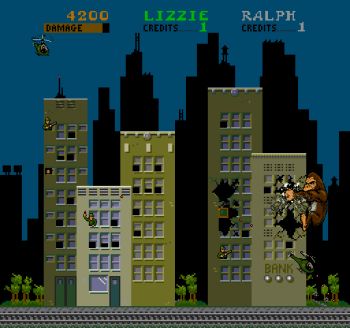
This arcade classic was one of the earliest to feature actual destructible buildings. The simple premise of selecting one of the three huge monsters and climbing on and knocking down buildings, eating people, and destroying vehicles was immense fun and ahead of the curve for its time.
Rampage was later ported over to home consoles like the NES and Sega Master System, and also received sequels on the Nintendo 64, PlayStation, and most recently, the Nintendo Wii.
Unfortunately, as time has gone on the Rampage series has only stagnated. Despite graphical upgrades and more playable monsters, the gameplay remained almost unchanged and never innovated on its original idea. Rampage has sadly slipped into the category of games that developers release to cash in on the memory of a classic title — one that many of today’s gamers probably don’t even remember.
1995 – Worms (Amiga)
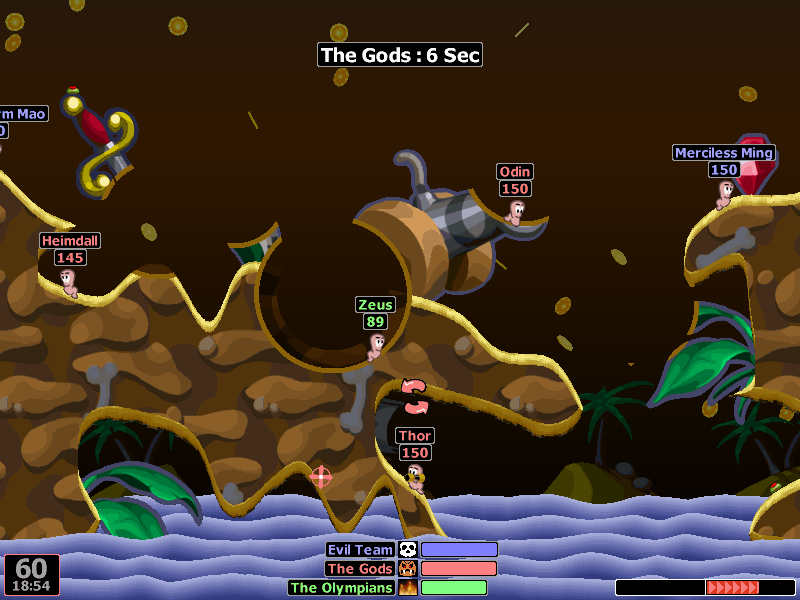
Team 17’s Worms, which was originally released for the Commodore Amiga computer, featured one of the more unique ideas of its time; using a wide array of unique weapons, players controlled a small platoon of worms over deformable terrain and battled either human- or computer-controlled teams.
While deformable terrain wasn’t really the main draw of this game, it was neat and impressive for its time and would catch you off guard if you judged the game on its visuals alone.
1997 – Blast Corps (Nintendo 64)
Developer Rare struck gaming gold during the N64 days, and things didn’t get much better than in 1997. GoldenEye 007 was released (which some of you may have heard of), as was Blast Corps, a game that had players clearing the way for an out-of-control nuclear missile carrier by using an array of current and futuristic vehicles.
It was a great, new idea that grew ever challenging as the game progressed. It also prided itself on the complete and utter destruction of every building that stood in your way. But blowing up buildings wasn’t the only thing Blast Corps had going for it. There was also a good deal of strategy to it. Some vehicles, like the Optimus Prime-looking J-Bomb took advantage of a jetpack to fly into the air before slamming down and crushing the structures beneath, while others like the Backlash dump truck required players to gain speed and power slide through buildings to plow them out of the way.
But no matter what vehicle was used to destroy everything in the environment, it always resulted in a lot of huge, colorful explosions.
2001 – Red Faction (PS2, PC)
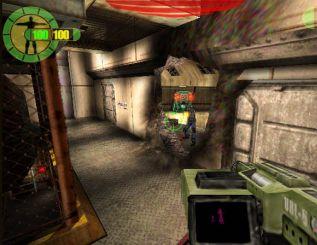
This game pretty much pioneered the term "destructible environments." In the PS2’s youth, the system was going through a serious game drought, especially in the FPS department. Early in the summer of 2001, though, it received a shooter that really demonstrated the PS2’s power.
Using "Geo-mod" technology, Red Faction allowed players for the first time to alter the terrain with explosives how they saw fit. You could blast a hole in the rock around a locked door or destroy a bridge an enemy vehicle was driving across. Hell, within the first few levels, players could tunnel down until they discovered a hidden lake, which served little purpose other than to showcase the game’s destructible terrain.
While the engine proved to be much more limited than gamers would have liked, it was well suited for multiplayer games taking place in smaller arenas. Players could create their own caves to snipe from, or blow shortcut tunnels in CTF games.
The sequel for Red Faction came out the following year and featured more of the same destructibility, but wasn’t received as well as the first. Following a different cast of characters and storyline, the game was set on Earth instead of Mars and felt too far removed from the previous game. It was also a very short and linear experience. The multiplayer aspect was enhanced with the inclusion of bots, extending the game’s replay value by quite a bit, however.
2002 – MechAssault (Xbox)
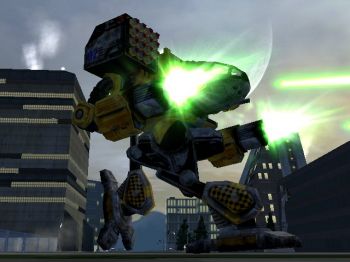
If piloting massive, armed, walking robots and leveling entire cities while fighting off your enemies sounds like an awesome idea, that’s because it is, and it was called MechAssault.
The game’s powerful, walking Mechs could punch giant dents in buildings with their weaponry, exposing rebar and insulation before eventually bringing them down to a pile of dusty rubble. Taller buildings could also be brought down to crush enemy Mechs and infantry with satisfyingly explosive results.
MechAssualt also became one of the Xbox’s premier titles to utilize the Xbox Live online service.
2002 – Robot Alchemic Drive (PS2)
This rare title escaped the attention of most gamers (including myself) and slipped into obscurity rather quickly. And although it featured huge walking robots battling each other, the scale was much, much larger than anything in MechAssault.
Players took control of Meganites — large, walking robots controlled by remote (there was no cockpit) — and fought off the invading alien Volgara in large cityscapes that could be ripped to shreds from the ensuing battles. The destruction of city buildings wasn’t encouraged, but a little ‘collateral damage’ was often unavoidable, as seen in the video above.
Is it just me, or do the anime-style graphics and robot designs look like a cross between Transformers and The Power Rangers?
2003 – War of the Monsters (PS2)
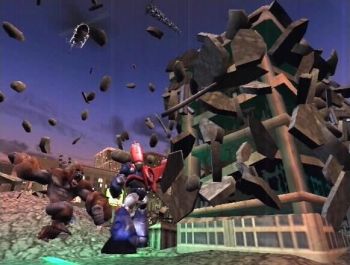
‘50s style, 100-foot-tall monsters meet Wrestlemania in this excellent brawler from Incog. Drawing inspiration from film legends like Godzilla, King Kong, and The Beast From 20,000 Fathoms, players chose from 10 beasts to fight as, and went at it in fully destructible environments.
Not only were the environments destructible, they also encouraged interaction. Cars and telephone poles could be ripped from the ground and used as weapons. Throwing your enemies into buildings caused them not only to crumble, but it revealed more weapons like rebar that could be used to impale your foes.
Respectable audio and visuals, even by today’s standards, were only hampered by somewhat floaty controls and a bothersome camera.
2005 – Mercenaries (Xbox, PS2)
What do you expect from a game with the tagline "Playground of Destruction"?
Mercenaries gave players not just any open world to unleash total annihilation in, but a current one making headlines — North Korea. Choosing one of three characters, players traversed the open North Korean terrain working for factions and taking contracts to eliminate/capture members of the Deck of 52, a group of 52 "most wanted" officers.
But that wasn’t what the game was known for. What it was known for was its destruction-on-demand style of gameplay that let you call in air strikes, artillery, carpet bombs, bunker busters, and more to wipe out enemy buildings, towns, and airports whenever the heck you wanted to. You could even call in supply drops for weapons, health, and ammo if you needed it.
However, while players had free reign of the destruction, killing civilians and destroying non-enemy buildings hurt your reputation with certain factions and made you lose money. No one ever said you couldn’t nuke a civilian town and reload your previous save, though.
2005 – The Incredible Hulk: Ultimate Destruction (Xbox, PS2, GameCube)
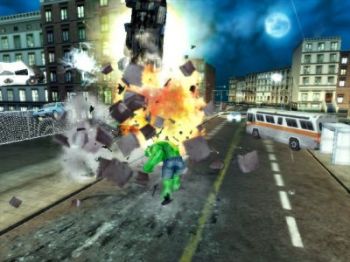
The Hulk and ultimate destruction are two things that seem to go perfectly hand in hand with one another, so it’s no surprise that someone thought of the idea to combine them and turn it into a videogame. What can I say? It was meant to be.
Even to this day, this game impresses me with its nonstop action. There is nothing in this game that can’t be destroyed, jumped on, climbed over, picked up and thrown, or used as a weapon in some way. It’s really only limited to the player’s ability to process all the explosions and sounds and turn the situation into something creative and destructive.
2007 – Stranglehold (Xbox 360, PS3, PC)
When Stranglehold came out during the infancy of the Xbox 360 and the PS3 it got ignored by many gamers, but that didn’t mean it wasn’t a notable shooter.
It also didn’t do anything drastically beyond what Max Payne did in the previous generation, but did make next-gen improvements to the formula. One area that got the next-gen treatment was, of course, the destructibility of the environments. Bullets tore chucks and pieces out of the walls, shattered glass,and made things explode and spark in beautiful fashion, all in slow motion and in HD. The destruction wasn’t on the same scale as Red Faction, so you weren’t bringing down entire buildings or blowing gaping holes in walls, but it was still impressive, satisfying, and fit the style of game very well.
The obliteration was encouraged for defeating enemies and for nabbing yourself some nifty achievements, too. Shooting hanging signs would sometimes take out multiple enemies, and players were awarded an achievement for completely destroying a dinosaur skeleton in a museum level.
Playing the game now does expose some problems that make it obvious it was a first generation title on new consoles, but the action is still there, the gunplay is satisfying, and the destruction brings back memories of watching the lobby scene in The Matrix.
2008 – Battlefield: Bad Company (Xbox 360, PS3)
Battlefield is a franchise that needs no introduction for PC fans, but for console fans, it’s not quite as well known. Generally known for its hectic and fun multiplayer battles, soldier classes, and vehicles, destructible environments came as a welcome innovation to DICE’s underrated FPS Bad Company.
And the new Frostbite engine was more than up to the task to create some of the most realistically destructible environments to date. Grenade launchers could blow huge holes in any building, and trees could be mowed down with vehicles or gunfire. Entire villages could be wiped from the map after particularly nasty battles or inaccurate air strikes. Unlike most games, the destruction here had a "real" feeling to it, especially when looking around a town after a battle had taken its toll. It also changed the way you fought the enemy, since any cover you found could usually be destroyed in an instant.
Bad Company also featured some devastating sound effects to go along with all the action.
The newest release from DICE is Battlefield 1943, a remake of a PC classic for the XBLA and PSN which uses the same Frostbite engine as Bad Company, so the environmental destruction and all-around graphical quality is very similar.
2009 – Red Faction: Guerrilla (Xbox 360, PS3, PC)
Red Faction: Guerrilla is pretty much the new golden standard for how destructible environments should be done. Instead of focusing on realism, Volition chose to make the destruction more fun and over the top; buildings explode and crumble to the ground how you want them to, not how they always should thanks to the new "Geo-Mod 2.0" technology.
Every building in Red Faction: Guerrilla is destructible (and I do mean every building), and using different tools from your arsenal of annihilation will cause it to collapse differently every time. You can whittle around the outside using the universe’s most powerful hammer, ripping out rebar, reinforcement beams, and drywall until the building starts to lean and creak before coming down all at once. You could vaporize it from the inside out using the Nano Rifle, use remote-detonated explosives to take out its strongest points, or blast it to dust in one shot using a Thermobaric Rocket. Hell, you don’t have to even shoot anything, you could just get in a truck and drive straight through it. The possibilities are almost endless and are always entertaining.
Throw in some very solid multiplayer action, great missions, and some bumpin’ audio, and you have yourself one of the best titles of the year so far, and one of the best ever in the family of videogame’s destructible environments.
Did I miss anything? Feel free to leave any comments about some worthy games you played where the destruction really got your attention.

















